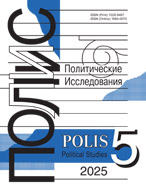“Velvet Revolution” in Armenia:
Potential, Gains and Risks of Political Protest Activity
Atanesyan A.V.,
Professor, Yerevan State University, atanesyan@yandex.ru
elibrary_id: 962408 | ORCID: 0000-0001-8458-2447 | RESEARCHER_ID: AAZ-9173-2021
DOI: 10.17976/jpps/2018.06.06
Atanesyan A.V. “Velvet Revolution” in Armenia: Potential, Gains and Risks of Political Protest Activity. – Polis. Political Studies. 2018. No. 6. https://doi.org/10.17976/jpps/2018.06.06
The paper is focused on the public protests in Armenia in spring 2018 which caused the change of ruling elites. The new elite announced perspective directions of modernization, mostly in internal politics, including fight against authoritarian regime, corruption and economic monopoly developed by the previous government. It is demonstrated that the protests and slogans of spring 2018 are logically connected with accumulated culture and potential of protesting against institutionalized mechanisms of circulation of ruling elites inside the same political-oligarchic group and reflected public disagreement with situation in domestic economy and policy (which also caused mass emigration from the country). Comparably high level of freedom of speech in the country, critical public discourse on the lasting domestic issues, stagnation and on the failures of the ruling elites to tackle them influenced accumulation of protest potential, as well as accompanied public protests of the last decade, including the recent one. The arguments of the paper are based on author’s involved observations during mass protests in Armenia in April-May 2018, analysis of mass media and online publications, public discussions in social media, as well as interviews with Armenian experts – sociologists, political scientists, cultural anthropologists, historians and journalists. Along with that, secondary analysis of sociological and statistical data collected prior to the protests in 2018 and demonstrating the level of trust to political institutions, public perceptions on actual political and economic issues, as well as on participation in antigovernment protests, is implemented and serves as the context to demonstrate actual background for the recent protests. The paper represents an explanatory attempt to assess the causes of the protests and change of government in spring 2018 in Armenia, as well as to describe the forms of protest behavior, including communication and interaction models of the protesters. There is also an attempt to find out and demonstrate some risks and dysfunctions of the protest activities and especially post-protest political processes in the country, including construction and development of misperceptions and biased forms of framing of the mass protests in 2018 in the communication and media environment.
References
Borgesius F.J.Z., Moller J., Kruikemeier S., Fathaigh R.O, Irion K., Dobber T., Bodo B., de Vreese C. Online Political Microtargeting: Promises and Threats for Democracy. – Utrecht Law Review. 2018. Vol. 14. No. 1. P. 82-96. http://doi.org/10.18352/ulr.420
Breuer A. The Role of Social Media in Mobilizing Political Protest Evidence from the Tunisian Revolution. Bonn: Deutsches Institut fur Entwicklungspolitik gGmbH. 2012. 33 p. URL: https://www.die-gdi.de/uploads/media/DP_10.2012.pdf (accessed 09.09.2018).
Buzan B., Waver O., de Wilde J. Security. А New Framework for Analysis. Lynne Rienner Publishers Inc. 1997. 239 p.
Carlisle J.E., Patton R.C. Is Social Media Changing How We Understand Political Engagement? An Analysis of Facebook and the 2008 Presidential Election. – Political Research Quarterly. 2013. Vol. 66. No. 4. P. 883-895. https://doi.org/10.1177/1065912913482758
Chebib N.K., Sohail R.M. The Reasons Social Media Contributed to The Egyptian Revolution. – International Journal of Business Research and Management. 2011. Vol. 2. No. 3. P. 139-162.
Fomin I.V., Silaev N.Yu. Armenian Nationalism vs. Armenian State: Cleavages and Coalitions in the Discourses on Sasna Tsrer. – Polis. Political Studies. 2018. No. 3. P. 78-92. (In Russ.) https://doi.org/10.17976/jpps/2018.03.06
Gandi M. Revolyuciya bez nasiliya [Revolution without Violence]. Moscow: Algoritm. 2012. 480 p. (In Russ.)
Habrieva T. YA., Chirkin V. E. “Cvetnye revolyucii” i “arabskaya vesna” v konstitucionnom izmerenii [“Colored Revolutions” and “Arab Spring” in the Constitutional Dimension. Moscow: Norma, INFRA M. 2018. 192 p. (In Russ.)
Kalsnes B. The Social Media Paradox Explained: Comparing Political Parties’ Facebook Strategy Versus Practice. – Social Media + Society. April-June. 2016. P. 1-11. https://doi.org/10.1177/2056305116644616
Lane D. The Orange Revolution: ‘People’s Revolution’ or Revolutionary Coup? – BJPIR. 2008. Vol. 10. P. 525-549. https://doi.org/10.1111/j.1467-856x.2008.00343.x
Lange S. The End of Social Media Revolutions. – The Fletcher Forum of World Affairs. 2014. Vol. 38. No. 1. Winter. P. 47-68. URL: https://static1.squarespace.com/static/579fc2ad725e253a86230610/t/57ec77fabe6594808a454108/1475115002886/38-1_Lange1.pdf (accessed 15.09.2018).
Larsson A.O., Kalsnes B. ‘Of course we are on Facebook’: Use and non-use of social media among Swedish and Norwegian politicians. – European Journal of Communication. 2014. Vol. 29. No. 6. P. 653-667. https://doi.org/10.1177/0267323114531383
Marzouki Y., Skandrani-Marzouki I., Be´jaoui M., Hammoudi H., Bellaj T. The Contribution of Facebook to the 2011 Tunisian Revolution: A Cyberpsychological Insight. – Cyberpsychology, Behavior, And Social Networking. 2012. Vol. 1. No. 5. P. 237-244. https://doi.org/10.1089/cyber.2011.0177
Metzger M.M., Tucker J.A. Social Media and EuroMaidan: A Review Essay. – Slavic Review. 2017. Vol. 76. No. 1. P. 169-191. https://doi.org/10.1017/slr.2017.16
Naumov A.O. “Colored Revolutions” on the Post-Soviet Space: View Ten Years Ago. – Gosudarstvennoe upravlenie. 2014. No. 45. P. 148-178. (In Russ.)
Ott B. L. The Age of Twitter: Donald J. Trump and the Politics of Debasement. – Critical Studies in Media Communication. 2017. Vol. 34. No. 1. P. 59-68. http://dx.doi.org/10.1080/15295036.2016.1266686
Salanova R. Social Media and Political Change: The Case of the 2011 Revolutions in Tunisia and Egypt. Institut Catala Internacional per la Pau Barcelona. Working Paper No. 2012/7. 2012. December. 63 p.
Salvador P., Vivar P.C., de Vera E., Inocian R.B., Rosaroso R.C. Influence of Facebook to Voters’ Political Practices. – Asia Pacific Journal of Education, Arts and Sciences. 2017. Vol. 4. No. 1. P. 15-23.
Shepherd R. Czechoslovakia: The Velvet Revolution and Beyond. London: Palgrave Macmillan. 2000. 204 p. https://doi.org/10.1057/9780230288638
Siushkin A.E., Milaeva O.V. Teorii sotsial’noi revolyutsii KhKh veka v Zapadnoi Evrope i SShA: obzor osnovnykh napravlenii [Theories of Social Revolution of the XX Century in Western Europe and USA: Review of the main Directions]. – Vzglyad cherez stoletie: revolyutsionnaya transformatsiya 1917 goda (obshchestvo, politicheskaya kommunikatsiya, filosofiya, kul’tura). Sb. st. vserossiiskoi nauchno-prakticheskoi konferentsii (g. Penza, 29-30 sentyabrya 2017 goda, g. Penza). Pod red. O.V. Milaevoi, O.V. Chernovoi [A Glimpse through the Century: the Revolutionary Transformation of 1917 (Society, Political Communication, Philosophy, Culture). Collection of Articles of the All-Russian Scientific and Practical Conference (Penza, September 29-30, 2017). Ed. by O.V. Milaeva, O.V. Chernova. Praga: Sociosfera-CZ. 2017. P. 190-208. (In Russ.) https://doi.org/10.24045/conf.2017.1.19
Sorokin P.A. Sociologiya revolyucii [Sociology of Revolution]. Moscow: ROSSPEN. 1998. 703 p. (In Russ.)
Sundiev I.Yu., Smirnov A.A. Teoriya i tekhnologii social’noj destrukcii (na primere “cvetnyh revolyucij”) [Theory and Technologies of Social Destruction (on Example of “Color Revolutions”)]. Moscow: Russian Biographical Institute, Institute of Economic Strategies. 2016. 433 p. (In Russ.)
Taylor P.A., Harris J.L. Critical Theories of Mass Media: Then and Now. N.Y.: Open University Press. 2008. 233 p.
The Handbook of Media and Mass Communication Theory. Ed. by Fortner R.S., Fackler P.M. Malden: John Wiley & Sons, Inc. 2014. 1008 p.
The Role of Social Media in the Arab Uprisings – Past and Present. Ed. by Taki M., Coretti L. – Westminster Papers in Communication and Culture. 2013. Vol. 9. No. 2. 122 p.
Tilly Ch. From Mobilization to Revolution. N.Y.-London: McGraw-Hill Publishing Co. 1978. 349 p.
Wolfsfeld G., Segev E., Sheafer T. Social Media and the Arab Spring: Politics Comes First. – The International Journal of Press/Politics. 2013. Vol. 18. No. 2. P. 115-137. URL: http://journals.sagepub.com/doi/pdf/10.1177/1940161212471716 (accessed 09.09.2018).
See also:
Akhremenko A.S., Stukal D.K., Petrov A.P.,
Network vs Message in Protest Diffusion on Social Media: Theoretical and Data Analytics Perspectives. – Polis. Political Studies. 2020. No2
Vasileva V.M., Vorobyev A.N.,
Corruption Markets. – Polis. Political Studies. 2015. No2
Linetsky A.I.,
Variety of political systems as consequence of differences in people’s behavior. – Polis. Political Studies. 2013. No6
Köchler H.,
The new social media: chance or challenge for dialogue?. – Polis. Political Studies. 2013. No4
Sergeyev K.V.,
«What is impossible to speak about...» phenomenon of «unutterable demands» and social risks in modern society. – Polis. Political Studies. 2013. No4




.jpg)






 print
print
.jpg)
.jpg)